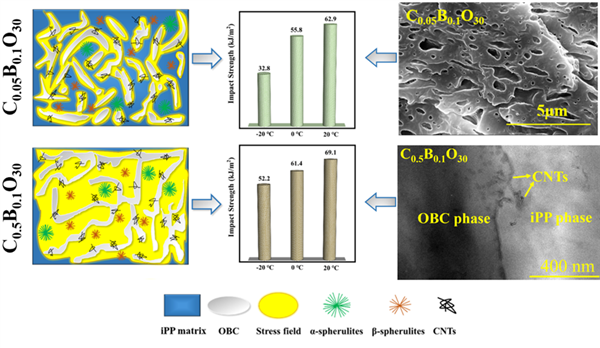作者:Zhong-Guo Zhao, Sheng-Tai Zhou, Li-Jun Quan, Wei-Long Xia, Qian Fan, Peng-Hui Zhang, Yan-Hui Chen*,
关键字:Isotactic polypropylene, Carbon nanotubes, Ethylene-octene multiblock copolymer,Low-temperature toughness,Co-continuous phase morphology
论文来源:期刊
具体来源:Industrial & Engineering Chemistry Research, 2022, 61, 41, 15240-15248.
发表时间:2022年
等规聚丙烯(iPP)是一种常用的热塑性工程塑料材料,在过去的几十年里被广泛的用来制造购物袋、管材、农用薄膜以及其他的工业应用。然而,随着使用温度的降低,会极大地影响聚丙烯的韧性,会导致其由韧性到脆性的转变,造成聚丙烯复合材料力学性能的恶化,这也大大的限制了聚丙烯管材在极端寒冷环境下的进一步应用。课题组针对聚丙烯耐寒问题,通过对聚丙烯复合材料内部微结构的调控,使iPP/0.1wt% β-NAs/30 wt% OBC共混体系具有超高的低温冲击韧性。与纯iPP相比,在仅添加0.5wt% CNTs时,可使iPP/0.1wt% β-NAs/30 wt% OBC复合材料在使用温度为-20℃时,低温冲击韧性高达52.2kJ/m2,其中冲击强度增加幅度约2386%。通过CNTs添加含量的调控可使β-iPP复合材料形成共连续的相形态,这是复合材料在低温环境下能显著增强应力消散的关键。此外,CNTs在iPP和OBC相之间的分布以及β-NAs和OBC诱导的自增韧β-晶体的存在将有助于进一步提高iPP基复合材料的低温冲击强度。本课题组提出了一种切实可行的增强复合材料低温韧性的策略,扩大了其在工业领域的应用潜力。
Isotactic polypropylene (iPP), as a common engineering thermoplastic material, is widely selected to manufacture shopping bag, pipe, agricultural film and other industrial applications inpast decades. However, decreasing the using temperature can induce thetransition from ductile to brittle failure of iPP, thereby inducing the dramatic deterioration of mechanical properties. Therefore, the poor low-temperature impact strength of iPP (especially below glass transition temperature, Tg) largely restricts its further applications in frigid environment such as outdoor pipelines. To broaden the potential application of isotactic polypropylene (iPP) in low-temperature conditions, iPP/0.1 wt% β-nucleated agent/30 wt% ethylene-octene multiblock copolymer (iPP/0.1 wt% β-NAs/30 wt% OBC) blends were endowed with ultrahigh low-temperature impact toughness by adjusting the nanotubes (CNTs) content. In comparison with pure iPP, the low-temperature impact toughness of iPP/0.1 wt% β-NAs/30 wt% OBC composites with only adding 0.5 wt% CNTs reached as high as 52.2 kJ/m2 at -20 ℃, of which the increment of impact strength was about 2386%. This optimum content of CNTs gave rise to a co-continuous phase morphology in β-nucleated iPP composites which turned out to be the key to the greatly enhanced stress dissipation, even at low-temperature environment. In addition, the distribution of CNTs between iPP and OBC phase, and the presence of self-toughened β-crystals that were induced by β-NAs and OBC contributed to improving the low-temperature impact strength of iPP-based composites. A feasible strategy is developed to substantially reinforce the low-temperature toughness of iPP-based composites, which expands their potential applications in industrial sectors.
